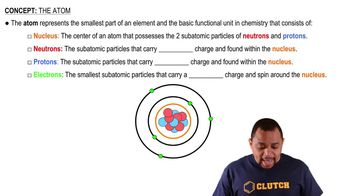One method to synthesize ionic solids is by the heating of two reactants at high temperatures. Consider the reaction of FeO with TiO2 to form FeTiO3. Determine the amount of each of the two reactants to prepare 2.500 g FeTiO3, assuming the reaction goes to completion. (a) Write a balanced chemical reaction. (c) Determine the moles of FeTiO3.
Ch.12 - Solids and Modern Materials
Chapter 12, Problem 132
Look up the diameter of a silicon atom, in Å. The latest semiconductor chips have fabricated lines as small as 14 nm. How many silicon atoms does this correspond to?
 Verified step by step guidance
Verified step by step guidance1
Step 1: Look up the diameter of a silicon atom, which is approximately 2.7 Å (angstroms).
Step 2: Convert the diameter from angstroms to nanometers. Recall that 1 Å = 0.1 nm.
Step 3: Calculate the number of silicon atoms that fit into 14 nm by dividing 14 nm by the diameter of a silicon atom in nanometers.
Step 4: Set up the division: Number of silicon atoms = 14 nm / (diameter of silicon atom in nm).
Step 5: Perform the division to find the number of silicon atoms that correspond to the 14 nm line.
Key Concepts
Here are the essential concepts you must grasp in order to answer the question correctly.
Atomic Diameter
The atomic diameter refers to the size of an atom, typically measured in angstroms (Å), where 1 Å equals 10^-10 meters. For silicon, the atomic diameter is approximately 2.3 Å. Understanding atomic size is crucial for calculating how many atoms fit into a given length, such as the 14 nm line width in semiconductor technology.
Recommended video:
Guided course

Atom Structure
Nanometers to Angstroms Conversion
Nanometers (nm) and angstroms (Å) are both units of length used in the field of chemistry and materials science. One nanometer equals 10 Å, which means that to convert nanometers to angstroms, you multiply the number of nanometers by 10. This conversion is essential for accurately determining the number of silicon atoms that fit into a specified length in angstroms.
Recommended video:
Guided course

Conversion Factors
Molecular Counting
Molecular counting involves determining the number of individual atoms or molecules in a given length or volume. In this context, once the diameter of a silicon atom is known and converted to the same unit as the line width (in Å), dividing the total length (in Å) by the atomic diameter allows for calculating how many silicon atoms can fit within that length. This concept is fundamental in nanotechnology and semiconductor fabrication.
Recommended video:
Guided course

Molecular Polarity
Related Practice
Textbook Question
Textbook Question
One method to synthesize ionic solids is by the heating of two reactants at high temperatures. Consider the reaction of FeO with TiO2 to form FeTiO3. Determine the amount of each of the two reactants to prepare 2.500 g FeTiO3, assuming the reaction goes to completion. (b) Calculate the formula weight of FeTiO3.
Textbook Question
One method to synthesize ionic solids is by the heating of two reactants at high temperatures. Consider the reaction of FeO with TiO2 to form FeTiO3. Determine the amount of each of the two reactants to prepare 2.500 g FeTiO3, assuming the reaction goes to completion. (d) Determine moles and mass (g) of FeO required.
